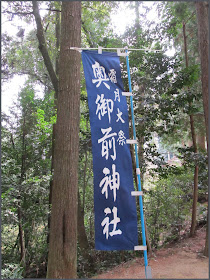:::::::::::::::::::::::::::::::::::::::::::::::::::::::::::::::::::::::::::::::::::::::::::::::::::::::::::::::::::::::::::::::::::::::::::::::::::::::::::::::::::::::::::::::::::::
Kifune Shrine Kume 貴布弥(きふね)神社(奥御前神社)
岡山県久米郡久米町桑上 Kuwakami village, Okayama
Visited in March 2013
This shrine is related to the Kifune shrine in Kyoto, since 1690, when it became a tutelary shrine for the Itakura regent of the region
板倉摂津守の御祈願所
. Kifune Shrine 貴船神社 Kyoto, Kurama .
Near this shrine is an old kofun grave mound area of the 6th century, where a lot of iron relics have been found.
So the manufacture of iron goods has a long tradition in the region.
Maybe the iron manufacturers brought the belief in the wolf deity with them.
Oku Osaki Jinja 奥御前神社
sanctuary at the back mountain in the wild forest

The forest around the shrine is rather "wild" and the atmosphere quite remote.

Make a salt offering !
Salt is used as a purification material in Japan. The blue plastic container has a few sacks of cooking salt inside, where you can help yourself.

A small heap of salt near the offerings box.

A hole at the back of the shrine to throw in salt.
Everything is green with moss and moisture at the back of this shrine.
It is said that wolves like to lick salt, hence the salt offerings.
(I have never seen this kind of salt offering hole at the back of a shrine.
Can anyone shed light on this custom?)

Stone altar at the back forest with salt offerings

Roots of the nearby tree and the stone altar

..................................................................................................................................................................

Gable of the main shrine building.

Large compound with simple stone lanterns.
All around the back are smaller shrines, dedicated to various deities.


A simple shrine with a simple stone basis to support and protect from rainwater.



..................................................................................................................................................................
Oku Osaki Jinja 奥御前神社
Here OSAKI, the "first sign of the main deity" 御先, the wolf servant of the Kifune deity, is worshiped.
Wolf Shrine 狼宮
Here a wolf deity is worshipped, Ookami sama 狼様, who is very helpful protecting people and their property from thieves and robbery.
The annual festival in December is in honor of this wolf.
狼様祭り Okami sama Matsuri
During the festival, the believers bring their old amulets from last year with thanks,
and get new ones for their house altar with new power to protect them.

amulet with wolves

offering for the annual wolf festival

. My Photo Album .
. The Wolf Shrine in Chichibu Mitsumine Jinja 三峰神社 .
Another legend says there is also a fox deity worshipped.
It protects the region from the floodings of the local river.
There is a hole at the side of the shrine where the fox can go in and out. People leave some nigirimeshi rice balls for the fox to appease him.

Before a flooding, the fox will give warning, calling kyan-kyan キャンキャン.
:::::::::::::::::::::::::::::::::::::::::::::::::::::::::::::::::::::::::::::::::::::::::::::::::::::::::::::::::::::::::::::::::::::::::::::::::::::::::::::::::::::::::::::::::::::
Deities in residence
Taka Okami 高寵神(たかおかみ) 高オカミ神
Kura Okami 闇寵神(くらおかみ)
These two are dragon deities who provide abundant water for the region.
They are the main deities of the Kifune shrine in Kyoto.
The traditional complex middle character for this deity タカオカミ is composed of
rain 雨 at the top, then three open mouths 口 and the dragon 龍 at the bottom.
and 8 others ほか八柱 (雷神 / 大山祇神 . . .)
The deity used to be called
Ooko Kifune Daimyoojin 往古貴布禰大明神, in Meiji the shrine was named shorter, Kifune Shrine.
Oku Osaki Jinja 奥御前神社
sanctuary at the back mountain
This is the most important shrine in the compound.
People come here to pray for protection from evil, protection from infectious diseases (important in the Edo period), protection from fire and thieves.
悪魔退散 伝染病除け 火難除け 盗難除け
The main festival is on December 13 - 15
Great Festival at the Wolf Shrine 狼宮大祭
貴布弥(きふね)神社(奥御前神社)
source : raifuku.net/special/wolf
:::::::::::::::::::::::::::::::::::::::::::::::::::::::::::::::::::::::::::::::::::::::::::::::::::::::::::::::::::::::::::::::::::::::::::::::::::::::::::::::::::::::::::::::::::::
quote
Kuraokami, Takaokami 高おかみ神, Kuramitsuha
Kami produced from the blood that dripped from Izanagi's sword when he killed the kami of fire, Kagutsuchi.
When Izanagi's consort Izanami gave birth to the kami of fire, she was burned and died. Enraged and saddened at the loss of his wife, Izanagi beheaded Kagutsuchi with his "ten-span sword," and numerous deities were produced from Kagutsuchi's blood.
According to Kojiki, Kuraokami and Kuramitsuha were produced from the blood as it collected on the hilt of Izanagi's sword and dripped through his fingers.
According to an "alternate writing" related by Nihongi, Izanagi killed Kagutsuchi by cutting him into three pieces, thus creating the three kami Ikazuchi no kami, Ōyamatsumi, and Takaokami.
The word kura is said to mean a narrow gorge beneath a cliff, while okami refers to the dragon tutelary of water, and mitsuha suggests the water as it begins to emerge, or a water-spirit.
source : Yumiyama Tatsuya, 2005, Kokugakuin
. Kagutsuchi カグツチ / 軻遇突智 Kagu-tsuchi - "incarnation of fire" .
- Homusubi no Mikoto 火産霊命
. Rain Rituals in Japan .
:::::::::::::::::::::::::::::::::::::::::::::::::::::::::::::::::::::::::::::::::::::::::::::::::::::::::::::::::::::::::::::::::::::::::::::::::::::::::::::::::::::::::::::::::::::
The Kume Kifune shrine faces the local river and a side-road of the Old Trade Road to Izumo, now the prefectural road 429.
It is located on a hill above the village Kuwakami 桑上, with steep steps up.
ーーーーー . 出雲街道 Izumo Kaido .
There was no access road for cars, so in modern times the villagers build one from the "back side", cutting through the mountain and the pristine shrine forest and reaching the "Wolf Shrine" first, then going down to the main shrine.
The slopes of this cut are quite remarkable, with sand waves, overhanging tree roots and small bonsai-like fern islands on the slopes.
Have a look here.
. Kifune Shrine - access road impressions .
:::::::::::::::::::::::::::::::::::::::::::::::::::::::::::::::::::::::::::::::::::::::::::::::::::::::::::::::::::::::::::::::::::::::::::::::::::::::::::::::::::::::::::::::::::::
寒戻り狼に逢うコケの森
kan modori ookami ni au koke no mori
cold coming back -
meeting a wolf
in the mossy forest
:::::::::::::::::::::::::::::::::::::::::::::::::::::::::::::::::::::::::::::::::::::::::::::::::::::::::::::::::::::::::::::::::::::::::::::::::::::::::::::::::::::::::::::::::::::
[ . BACK to DARUMA MUSEUM TOP . ]
[ . BACK to WORLDKIGO . TOP . ]
:::::::::::::::::::::::::::::::::::::::::::::::::::::::::::::::::::::::::::::::::::::::::::::::::::::::::::::::::::::::::::::::::::::::::::::::::::::::::::::::::::::::::::::::::::::

No comments:
Post a Comment
Note: only a member of this blog may post a comment.